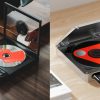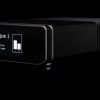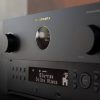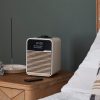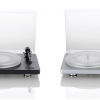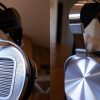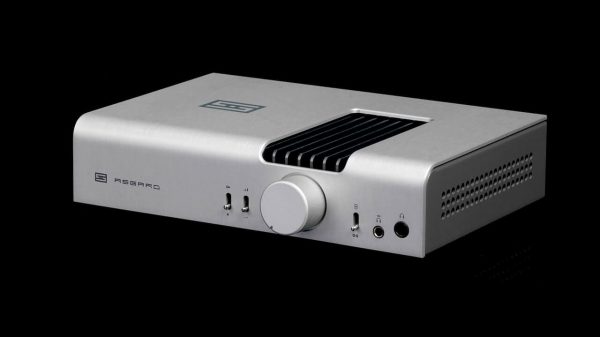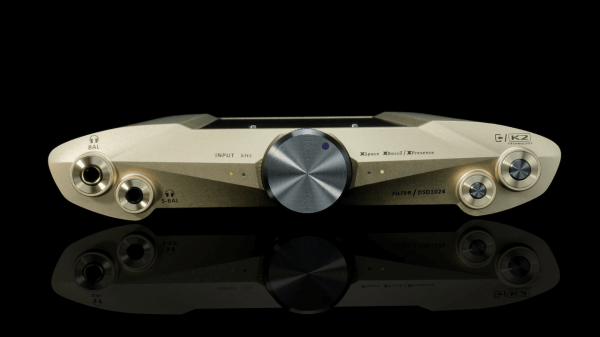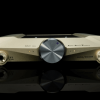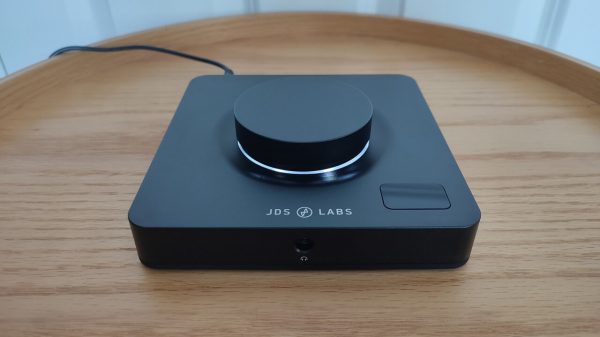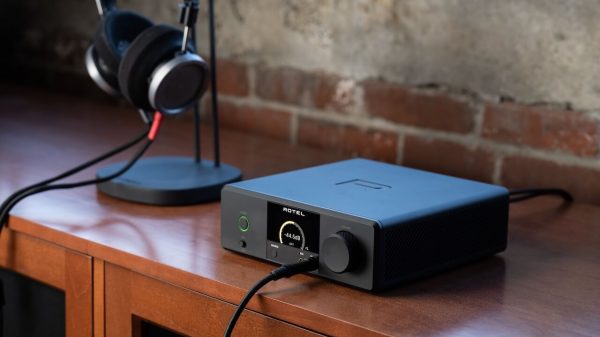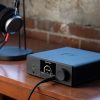Sometimes, little ideas become big ones. The high-end audio DIY space has always been a forum for engineers and creative tinkerers to come up with solutions to problems that most consumers wish they could fix themselves. Many of these solutions are modifications to existing products that make them better sonically but there is always risk involved with that.
Manufacturers do not pump their fists in solidarity with customers who replace key components that are not broken with 3rd party options and often refuse to honor the warranty when something breaks.
Changing the feet, installing better quality RCA jacks and binding posts, or damping a chassis with anti-vibrational compounds are rather benign modifications that are unlikely to break the component.
Modifying the circuit board or power supply is something else altogether.
I was introduced to SparkoS Labs several years ago because they design and manufacture discrete op-amps and power regulation circuits for both pro and home audio components.
At the time, I spoke to Andrew Sparks, SparkoS Labs’ CEO, and learned a bit about his passion for audio and their solutions for improving existing equipment by replacing the pieces that are most often compromised to fit within a budget.

SparkoS Labs were making discrete voltage regulators, discrete op-amps for home gear (360x series), a discrete op-amp for pro gear (2590 series), and kits to upgrade Marantz and Sansui receivers and integrated amplifiers that used the BA312 integrated circuits.
My first opportunity to listen involved replacing the stock NE5532 and NE5534 ICs in some consumer products with the SparkoS Labs SS3601 and SS3602 op-amps that were designed as drop-in replacements for the standard DIP-8 op-amps.
After a few days of listening, I noticed that both components sounded clearer and with much lower noise floors.
My first experience was so positive that I sought out a Marantz 2275 and listened to the unit in stock form and after installing one of the SparkoS Labs kits; the modified Marantz unit sounded clearer, more detailed, and significantly quieter.
If you own one of the older Marantz or Sansui amplifiers or receivers that utilizes the early BA312 ICs, it might prove to be very worthwhile to try one of their kits.
Over the past few yeas, I have also had the opportunity to listen to components with the SparkoS Labs SS2590 Pro discrete op-amps which were substituted for original 2250 and Jensen 990 Series op-amps. The biggest changes involved much quieter backgrounds and a more neutral sounding presentation.
RCA Studios recently upgraded all of their mic pre-amps using the SS2590 op-amps to improve sound quality and lower the noise floor.
SparkoS Labs components are now being used by pro audio and consumer brands that have integrated the SS360x series op-amps, voltage regulators, and power supplies into their components.
Nord, Apollon, VTV, and Mojo Audio products now ship with SparkoS Labs components under the hood.
Andrew Sparks came to the realization that it was time to create his own lineup of amplifiers after receiving so much positive feedback from manufacturers and DIY customers.
The SparkoS Labs Aries Series consists of a dedicated headphone amplifier and pre-amplifier that is offered in multiple variations. The base model ($2,495 USD) offers single-ended inputs and outputs, whilst the $2,995 USD version is fully balanced (offering both single-ended and XLR inputs/outputs).
The fully balanced version spent two weeks on my bench and desktop and proved to be a rather big surprise; its performance in comparison to some of the most respected dedicated headphone amplifiers currently available below $3,000 was rather unexpected.
The Skinny
SparkoS Labs went slightly overboard on the packaging but the flip side is that the Aries is very well protected inside. The box contains the amplifier, power cord, and a nice note from the company thanking the purchaser. One note — please remember to make sure that the voltage is set correctly before plugging the unit in.
The SparkoS Aries isn’t very large or heavy but the build quality is very solid and the heavy-gauge black aluminum shell keeps the internal components well protected. The chassis and cover are powder coated for durability; the finish is a tad rough but it is also more resistant to scratches and dings.

Features:
- 2 RCA Inputs
- Front Panel Input
- Optional XLR Input And XLR And RCA Outputs
- 3 Gain Settings +10, +20, +30 dB
- 64 Step, 1dB Per Step Attenuator For Volume And Balance
- 120V/240V 50Hz / 60 Hz AC Power Capability
- No Capacitors In The Signal Path
- DC And Overdrive Protection
- 2Hz – 350 KHz -3dB Bandwidth
- Precision 0.1% Tolerance Thin Film Resistors
- 355mA Peak, 14V Peak Output Capability
- Dimensions: Width 12.5″ Height 4.0″ Depth 12.5″
- Mu Metal Shielded Power Transformer
- Fully Discrete Audio Path Using Our SS2590 Discrete Op Amps
- Discrete Voltage Regulation Using Our SS78XX / SS79XX
- < 0.1 Ohm Output Impedance
- High Damping Factor
- 16 – 300 Ohm Headphone Impedance
- Touch Screen Control
- Customizable Touch Screen Colors
- All Connectors Are Gold Plated
- 1.6 uV RMS Noise at 0 db Gain 20 Hz – 20KHz Unweighted
- 9400uF Per Rail Power Supply Capacitance
- 0.5 Watts RMS into 300 ohms, 2.8 Watts RMS into 32 ohms

The front panel features a central touch screen display with a large single knob on either side; one acts as the balance control, and the other serves as the volume knob.
There are two headphones jacks on the front panel which offer 3.5mm and 6.35mm connectivity. One interesting quirk is that users can select the function of either knob; you can dictate which one controls the volume or balance.
The rear panel is a lot busier; there are two sets of RCA inputs, and 1 pair of XLR inputs on the left side of the panel. The RCA and XLR outputs occupy the right side of the panel. There is a 120/240V switch above the power receptacle and a placard in the box warns to be certain of the position before connecting power to the unit.

The overall weight proved to be a bit of a surprise because I expected a class A amplifiers with multiple voltages required for various components to require either multiple transformers or a large transformer with primary, secondary, and tertiary outputs.
Rather than using any of those designs, SparkoS Labs designed their own power supply for the Aries. They required 25V for the main power, 3.3V for the micro-controller and display, and 12V to some of the circuitry and relays in the Aries.
SparkoS Labs tried all the normal methods for stepping down voltage and found they either introduced too much noise or too much heat to be viable, so they designed a new “gated rectifier” that operates by charging capacitors during the upswing and downswing of the AC voltage.
As the voltage approaches the target, the window opens and caps begin to charge; as it leaves the target area, the window closes to prevent heat build-up or noise. By using the logic both on the upswing and the down, ripple is doubled in frequency and quartered in height making it easier to smooth out — creating very quiet clean power at all needed voltages.
SparkoS Labs omitted a VU meter on the display as well as it required the micro-controller to run at full speed which introduced too much noise. Instead, during music playback when the controls are not being actively manipulated, the micro-controller is put to sleep to remove any noise it would produce when active.

The Kishkas
The Aries starts with a shielded toroidal transformer that feeds a pair of SparkoS discrete voltage regulators. The brain of the Aries is a micro-controller that handles the display and UI functions as well as running the stepped attenuator volume control.
Because the volume control is a Reed relay stepped attenuator, you’ll find a quartet of the SS2590 Pro op-amps that act as the input and output stages. The SS2590 was used instead of the SS360x series as the 2590 has a higher output current which was needed due to the low impedance of the volume control.
The volume control is a 64 step attenuator with 1dB steps and uses 0.1% matched thin-film resistors for near perfect volume matching between channels and ridiculously low noise.
The “balanced” version of the Aries adds XLR inputs and XLR pre-amp outputs which are handled by SS360x series op-amps; it is important to note that there is not a balanced headphone output and while the pre-amp does offer XLR connections the electronics behind those connectors are single-ended.
There is no attempt to mislead here as everything is very clearly stated in the ad-copy and the XLR offers an additional ground connection not available in the RCA connector to help eliminate noise that might enter via that path.
One thing I did notice while examining the internal electronics is that there are no capacitors in the signal path. DC offsets are handled by a DC servo. When looking at the circuits, this is a no compromise design from start to finish and it shows in the specifications.
Measured at full volume, the noise floor is still at -130dB or 1.6uV of noise. This is lower than the vaunted Pass Labs HPA-1 or Benchmark HPA-4 that are often referenced as benchmark headphone amplifiers.

Using the Aries
There is no physical power switch with the unit going into standby mode as soon as the power cord is plugged in; hence the reason why SparkoS Labs tells you to check the voltage switch before you plug the unit in.
Once powered up, one needs to touch the soft power button on the lower right of the front display panel to bring the unit into operational mode.
The display itself and the UI is simple and easy to use and most features can be ea few taps. The main menu displays the volume level, balance, input type, gain level, lets users know if they are in headphone or pre-amplifier mode.
A quick touch of the settings button gives users accessibility to the rest of the input options, gain settings, and other functions.
The input option allows the user to select which RCA input or XLR input is engaged, while muting lets one power down the pre-amplifier outputs when using the device as a headphone amplifier.
There are 3 gain levels to choose from depending on the headphone being used, as well as an active clipping detection option that will reduce gain if clipping is detected.

Sound
I connected my RME ADI-2 DAC via the XLR input and my Bel Canto DAC to RCA input 1 to do my listening tests; headphones included the Beyerdynamic DT990 (600 ohms), Fostex 909, HiFiMAN HE-6, and a pair of Audeze LCD-3s to see what paired best with the Aries.
I also tried out the Empire Ears Wraith and Ultimate Ears Live IEMs to see how the Aries would handle more sensitive IEMs.
Because the Aries can be used as a pre-amplifier, I connected two pairs of powered monitors; the Edifier MR4 and the Adam Audio A7x to see how it would perform in that scenario.
What quickly became evident regardless of which headphone, earphone, or loudspeaker was being used is that the Aries vanished into the background. It proved to be one of the most transparent and clean sounding headphone amplifiers that I have tried to date.
The performance with IEMs was exemplary; backgrounds were eerily quiet; even with no signal and the volume set to its highest level, there was no hiss, hum, or any audible noise.
Having owned the Pass Labs HPA-1 Headphone Amplifier for the past few years, I have had the opportunity to try it with at least 100 pairs of headphones; its transparency, detail retrieval, and overall resolution is second to none. It easily belongs in any serious discussion about which headphone amplifier offers reference quality sound.

The SparkoS Labs Aries ranks alongside the HPA-1 in many of those categories and is one of the cleanest sounding headphone amplifiers currently available with almost no coloration regardless of which headphone or IEM I tried.
With the noise floor being so extraordinarily low, every last bit of detail that your DAC or source can decode is fully audible and that proved to be the case with products like the RME DAC, Bel Canto, and other high-quality DACs at my disposal.
Large planar magnetic designs like the HiFiMAN HE1000SE ($3,499) or Kennerton Thekk ($3,164) were unbelievable combinations but the flip side is that you can hear everything on the recording — and that includes things you may not want to hear.
A local friend who owns the dCS Bartok ($19,950) invited me over to compare the SparkoS Labs Aries and we both agreed that the trio (Bartok-Aries-HiFiMAN HE1000SE) may have been too much of a good thing.
Little things such as the shuffling of feet on the studio floor, conversations, and the breathing between notes — you can hear all of it. Does it ruin the performance?
Not really.
But is it somewhat distracting to hear that much detail and background information?
We both felt that we couldn’t listen to the same recordings the same way anymore because we would immediately notice the differences through lesser components.
The HE1000SE are not bass monsters, but the Aries delivered a different level of low end control that changed their presentation in rather dramatic fashion. Bass notes had greater solidity, texture, and far deeper extension than I was accustomed to with these headphones.
The Aries drove almost everything we threw at it; low impedance and high sensitivity IEMs, along with high impedance dynamic and planar magnetic headphones. Depending on what you are driving, the gain will need to be configured appropriately and the amount of headroom will vary.
The HiFiMAN HE-6 is a notoriously difficult load but proved to be quite usable on the high gain setting — but it does require the Aries to offer all that it can to really open up.
Using the Aries as a pre-amplifier demonstrated its value from a different perspective; both powered loudspeakers have very different tonal balances and levels of clarity and at no time did the SparkoS Labs Aries impart its own sonic signature on either of them. The Adam Audio A7x ($1,349/pr) have a much higher level of resolution than the inexpensive Edifier loudspeakers ($129/pr) and what became apparent is that the Aries was nothing more than a conduit with gain.
The neutrality of the Aries makes it rather ideal for those who wish to alter the tonal balance of their system with warmer sounding speakers or sources.
Conclusion
The upper echelon of headphone amplifiers is a rather small group of components; the Pass Labs HPA-1 ($3,675), Linear Tube Audio MZ3 ($3,700), and Benchmark HPA-4 ($2,999) have all earned that distinction because they deliver a state-of-the-art experience with a wide range of high-end headphones.

The SparkoS Labs Aries has to be considered part of that elite company for the simple fact that it is the most transparent sounding headphone amplifier of the group with an incredibly low noise floor that lets you hear absolutely everything on a recording. It has good punch in the low end but the tonal balance is ideal for a wide range of headphones and the Aries imparts none of its own coloration. The addition of the very capable pre-amplifier makes this one of the best kept secrets in the high-end headphone/personal audio category.
Does it make sense to spend $3,000 on a headphone amplifier?
If the bulk of your listening involves headphones and powered loudspeakers — the SparkoS Labs Aries delivers solid engineering and world class sound quality. Spending a penny more might be a waste of your money.
Where to buy:
- Full model – $2,995 at sparkoslab.som (includes both single-ended and XLR inputs/outputs)
- Base model – $2,495 at sparkoslab.som (single-ended only)



